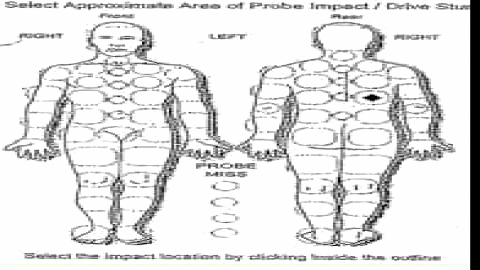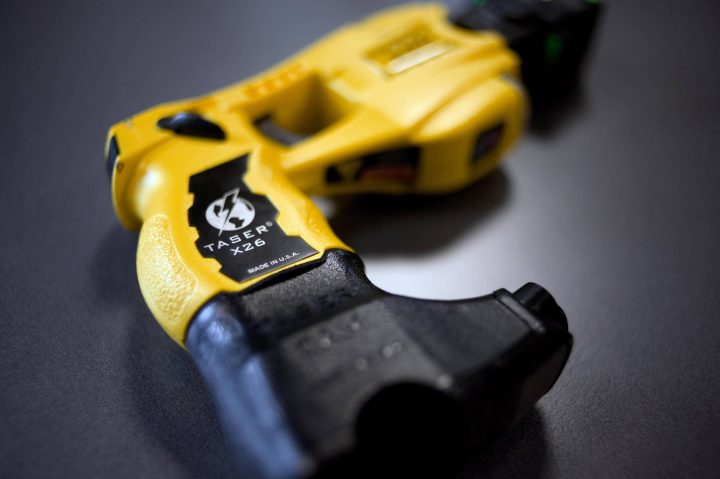The call came in just before 8 p.m. – a woman was threatening to kill herself. Police found her with a butcher knife pressed up against her neck.

One officer convinced her to lower the blade.
The other officer Tasered her anyway. Twice – once in the upper chest, once in the stomach.
The woman was apprehended under the Mental Health Act “without further incident.”
And that’s all we know: The date, location and any other identifying details of the 2013 incident have been scrubbed from publicly released records, as they have for each of the other hundreds of Taser incident reports Global News obtained from the Toronto Police through an access-to-information request. The 594 pages comprise all incident reports for Taser deployments, Taser use in drive-stun mode or Taser “demonstrated force presence” (when a Taser is shown but not fired) for 2013 and the first half of 2014.
Read the series:
How should we police Taser use?
What happens to you when you’re Tasered
- Budget 2024 failed to spark ‘political reboot’ for Liberals, polling suggests
- Peel police chief met Sri Lankan officer a court says ‘participated’ in torture
- Wrong remains sent to ‘exhausted’ Canadian family after death on Cuba vacation
- Liberals having ‘very good’ budget talks with NDP, says Freeland
Psychiatrists in blue: How do you train cops to be better social workers?
Who gets Tasered?
The people who get Tasered tend to be “emotionally disturbed” (read: suffering from mental illness or in the throes of personal crisis and acting erratically); they tend to be young and male and while police usually think they’re armed they frequently are not. Police Taser people who are actively uncooperative and people who seem intent on ending their own lives.
They’re disproportionately people who were in crisis and unwell; more than half of the individuals involved in Taser incidents in 2014 were identified by police as being “Emotionally Disturbed Persons.” Many are described as going “berserk,” of being drunk or high. A third of all incidents in 2014 resulted in people being apprehended under the Mental Health Act.
Most are 30 and under; on one occasion in 2014, a 15-year-old was Tasered in “drive stun” mode — apparently “to stop officers from being assaulted.”
WATCH: When can police use a Taser?
When are Tasers used?
Toronto Police had 579 Taser X-26s as of the end of last year, issued to members of the Emergency Task Force, front-line supervisors and supervisors of high-risk units. According to provincial policy, they’re only to be deployed or used in “drive stun” mode “when the subject is assaultive as defined by the Criminal Code, which includes threatening behaviour if the officer believes the subject intends and has the ability to carry out the threat, or where the subject presents an imminent threat of serious bodily harm or death which includes suicide threats or attempts.”
Last year Toronto Police used Tasers 227 times in 205 incidents. The plurality (about 10 per cent — twice its share of incidents in 2011) took place in 14 Division — a diverse area that includes Kensington Market, the Annex, Trinity-Bellwoods and Parkdale. This west-side neighbourhood also includes a high proportion of Torontonians with mental illness.
The documents we obtained have been scrubbed of both identifying details and outcomes: We don’t know what happened to these individuals after police apprehended them or brought them to hospital.
Some of the individuals described in the documents we obtained are “armed” with razor blades, kitchen knives, a length of lead pipe – but many don’t pose any real danger to anyone but themselves.
One man, tasered in the chest and stomach, was known to have “a history of mental illness” but there’s no indication in the incident report that any mental health practitioners were called to the scene as officers tried to communicate with him.
Why are Tasers used?
Police tasered a suicidal man twice – once in the stomach and once in the back – “to gain compliance” as he resisted being apprehended and handcuffed by officers.
In one instance, an officer tried to taser a man cutting his throat with a knife, but missed as the suicidal man backed toward his balcony. The rest of the incident report is censored: It isn’t clear whether the man killed himself.
Interestingly, the 2014 incident reports indicate a much more routine use of Tasers as a demonstration of force. Officers frequently pulled them out, often pointing their lasers at a subject, without deploying but as a way of demonstrating force in the hopes it would convince the individual to cooperate. (In one such incident, a suicidal man described as “known to police” took one look at the weapon, said he’d been tasered before and complied.)
On multiple occasions, the suspect was tasered after already being forced to the ground by police.
One man with mental illness, believed to be both drunk and high, was tasered three times while held on the ground by police. Another was tasered multiple times while lying on a mattress where he was apprehended.
Every time someone’s Tasered, police need to indicate on their incident report what body parts were hit. Here are some of the places people were Tasered in 2013-14:

On one occasion an “emotionally disturbed man” was tasered twice before and once after police took the knives he was holding away from him; the third occurrence was while he was being handcuffed.
A woman with mental illness in a state of crisis and threatening her own safety with knives was tasered multiple times – in her neck, in her left upper chest, in her abdomen and in her right arm.
A man described as “emotionally disturbed” and high on drugs was tasered five times in “drive stun” mode to various points on his back, left shoulder blade and left leg. The incident report states police thought he was armed with a knife; the weapon turned out to be a cell phone.
A man with mental illness holding a razor blade was tasered in the upper chest and stomach.
A woman in crisis who was yelling and screaming at police who barged into her apartment was tasered in the chest and right hip before being apprehended under the Mental Health Act.
A man who’d stabbed himself in the chest and was bleeding and asking officers to shoot him was tasered multiple times with two tasers in full deployment mode – once in the groin and twice in the upper chest.
An “emotionally disturbed man” was struggling and holding onto officers’ arms when he was tasered once, then again after he was on the ground. He was hit in the upper chest and stomach.
A suicidal woman threatening to kill herself with steak knives and believed to be on both alcohol and drugs was tasered at full deployment in the left shoulder.
WATCH: Toronto Police to request more tasers
Officers tasered an emotionally disturbed man who was “thrashing his body about” as he was being handcuffed by police.
A total of three tasers were used on one man threatening to slit his throat. Taser probes hit him in the chest and abdomen.
On one occasion, a taser was shot multiple times in “full deployment” mode because an unarmed suspect fleeing police “turned and squared off at the officer in an assaultive manner.”
Police tasered an intoxicated individual believed to be on both alcohol and drugs for five full seconds in “drive stun” mode in the chest once he was already in the back of a cop car.
At least two pit bulls were tasered in 2013, one after biting an officer.
In one case in 2013, officers taser what appears in the partially redacted description to be a fellow police officer “suffering a mental breakdown” and threatening to slit his own throat “upon being advised that he was being relieved of duty.” He was hit in the stomach and upper chest.
One man was tasered in the chest and hand while slicing at his neck with a razor blade.
READ MORE: Psychiatrists in blue: How do you train cops to be better social workers?
TASER FILES: Explore the documents
Tell us your story: Have you had an encounter with police while in crisis or struggling with mental illness? We want to hear from you.









Comments